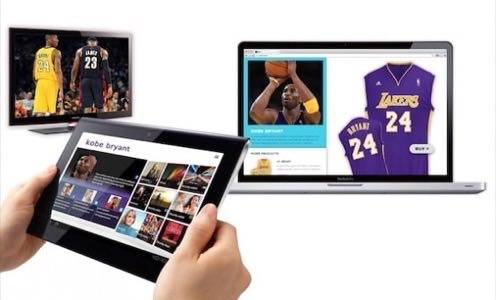
Social TV has a new player that’s worth watching. Last month, Vobile launched TVSync, an open platform that introduces new broadcast and cable TV streaming options. TVSync could finally do what predecessors dreamed of doing: mesh social media, streamed entertainment and curated content across multiple screens.
Big money is at stake. The U.S. media and entertainment industry is expected to spend $3.58 billion in digital ads this year and an estimated $6.19 billion by 2016, according to a September report from the digital marketing and media research site eMarketer.
With a slew of companies in the field, including GetGlue, Echo and even Apple, it may be crowded. But none of the players in the space marry both the social and e-commerce sides of the business. This opens the door for TVSync.
The month-old TVSync will mesh content, e-commerce and social networks across four screens – desktop, tablet, smartphone, smartTV – all in real time. TVSync could provide instant polling on reality shows and news events and embed live social-media activity in the show feed, or even into the storyline.
TVSync does all this through a white-label content-identification system that processesmore than 2 million videos and 8,000 hours of audiovisual content per day, according to Yangbin Wang, CEO of Vobile. That may be enough to service large traditional media companies with major data caches. The company’s pricing is designed to allow large media companies and smaller, upstart broadcasters and individuals to play in the space. (The price is determined by number and density of calls to the application programming interface per month and the size and length of audiovisual files available for matchmaking.)
“If you are a startup creating an app with a small installed base, then the cost would only be a fraction of that charged to a large media outlet with thousands of hours of cataloged content and millions of users,” Wang explained.
Linking Up Content
While rivals GetGlue, Echo and Shazam specialize in curating conversations and enabling content discovery, they haven’t leveraged that activity into sales. This is where TVSync is doing something different. The company has developed a smartphone innovation that makes purchases as easy as pointing and clicking.
Wang says consumers will be able to buy a team jersey during a game or merchandise hawked by TV show stars just by pointing their smartphone at the screen and holding the phone like they’re taking a picture. The service recognizes the content automatically, similar to IntoNow.
In a little less than a month, there have been more than 300 requests for access to the platform, which is compatible with iOS and Android. To get going, interested developers receive a software development kit that Yang says “includes everything developers need to utitlize the TVSync platform.”
If TVSync can get enough developers and traditional media organizations to adopt their service, build on top of it, and get major advertisers onboard, this new system could potentially become the dominant force in the emerging interactive TV space. Vobile, founded in 2005, has a history in Hollywood, helping the MPAA protect films from piracy. But it’s unclear whether the company will be able to use that background to secure future contracts.
Wang says he isn’t betting everything on TV. He wants to provide a new medium for Fortune 500 corporate training and content management. He says an editor using his platform can search for audiovisual content in a large digital library much faster than by searching a conventional content-management system.
Media Evolution Or . . . ?
Marketers have been clamoring for TV-driven e-commerce since the early days of the Internet. Could TVSync make it happen?
“It’s clearly a step in the right direction [for app developers],” said Brian Norgard, the co-founder and chief executive of Chill, a social video discovery site with 19 million registered users and a recent $8 million round of funding.
Norgard thinks TVSync could catch on, and cites the open-platform approach as a major reason. He says opening traditional and cable broadcasting television’s historically closed platform could lead to innovation within the medium.
“I think what they’re saying is, let’s skip building the consumer app layer and let everyone build on top,” Norgard explained. “The technology they’re providing opens up a lot of possiblites and makes a closed platform less closed.”
Brian Steinberg, TV editor for Ad Age, remains unconvinced that social TV has enough of a future to make this kind of service successful longterm. He thinks the field can’t sustain the growing demand for return on investment in ad revenue. In a crowded field, Steinberg says, TVSync will face a challenge in winning over content creators.
“Ultimately I think social TV is in a bit of a bubble right now,” Steinberg said. “It’s not quite clear to me that the audience they attract watch the shows and take part of what advertisers want to do.”
This year Twitter spent almost $260 million on ads in the U.S., mostly on big television shows and news events, like the Video Music Awards, Grammys, Emmys and the Super Bowl. It hoped to capitalize on content with heavy engagement, like AMC’s Breaking Bad, said Clark Fredricksen, vice president of communications for eMarketer.
Fredricksen sees TVSync less as a social platform and more as an e-commerce tool.
“The social component seems pretty small,” he said. “What it really sounds like is an open API that allows a publisher or a studio to integrate on their side. Then the TV viewer would integrate on their site.”
The digital marketing strategist says the area is hot but crowded. The draw for TVSync could be the e-commerce function.
“Marketers are very interested in reaching people from that second screen,” Fredricksen said. “The prospect of adding a commerce component to that already engaging environment is very compelling.”
The possibilities are truly limited to what marketers come up with and the deals TVSync can broker. Right now the door is open to the potential for broadcasters, cable companies, publishers and entrepreneurs to synchronize video or audio content with connected TV and second-screen experiences. Stay tuned.










